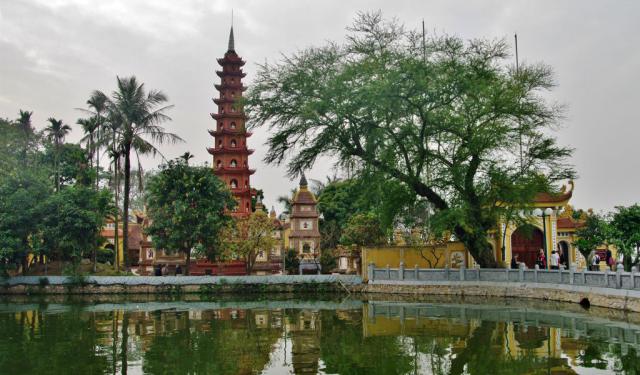
Tran Quoc Pagoda, Hanoi
The Tran Quoc Pagoda, located on a small peninsula between the West Lake and Truc Bach Lake in Hanoi, is the oldest pagoda in Vietnam. It was constructed in the 6th Century, during the reign of Emperor Ly Nam De, who was also called the Khai Quoc ( National Founder).
The Tran Quoc pagoda is built in the tradition of the Indian Stupa. It is a tall, tower like structure where religious relics were placed for veneration. The architecture used for the pagoda itself and surrounding structures is in harmony with nature and adds to the natural setting without disturbing the scenery. The ancient pagoda underwent extensive restoration in 1815. It now has a triple gate, sitting room, an ancestor worship chamber and a garden tower. The ancient corridors, ten shrines and a belfry are carefully preserved. The pagoda has many statues including a lacquer and gold statue of the Buddha and many steles including a stele depicting the history of the Pagoda by Nguyen Xuan Chinh crafted in 1639. The Bodhi tree in the gardens, grafted from the original Bodhi tree under which the Buddha attained enlightenment, was a gift from the Government of India during the visit of their first president in 1959.
The Tra Quoc Pagoda is a cultural symbol of Vietnamese Buddhism and remains a place of pilgrimage. International visitors are required to follow a strict dignified dress code and men and women are expected to cover their legs when visiting the temple.
The Tran Quoc pagoda is built in the tradition of the Indian Stupa. It is a tall, tower like structure where religious relics were placed for veneration. The architecture used for the pagoda itself and surrounding structures is in harmony with nature and adds to the natural setting without disturbing the scenery. The ancient pagoda underwent extensive restoration in 1815. It now has a triple gate, sitting room, an ancestor worship chamber and a garden tower. The ancient corridors, ten shrines and a belfry are carefully preserved. The pagoda has many statues including a lacquer and gold statue of the Buddha and many steles including a stele depicting the history of the Pagoda by Nguyen Xuan Chinh crafted in 1639. The Bodhi tree in the gardens, grafted from the original Bodhi tree under which the Buddha attained enlightenment, was a gift from the Government of India during the visit of their first president in 1959.
The Tra Quoc Pagoda is a cultural symbol of Vietnamese Buddhism and remains a place of pilgrimage. International visitors are required to follow a strict dignified dress code and men and women are expected to cover their legs when visiting the temple.
Want to visit this sight? Check out these Self-Guided Walking Tours in Hanoi. Alternatively, you can download the mobile app "GPSmyCity: Walks in 1K+ Cities" from Apple App Store or Google Play Store. The app turns your mobile device to a personal tour guide and it works offline, so no data plan is needed when traveling abroad.
Tran Quoc Pagoda on Map
Sight Name: Tran Quoc Pagoda
Sight Location: Hanoi, Vietnam (See walking tours in Hanoi)
Sight Type: Religious
Guide(s) Containing This Sight:
Sight Location: Hanoi, Vietnam (See walking tours in Hanoi)
Sight Type: Religious
Guide(s) Containing This Sight:
Walking Tours in Hanoi, Vietnam
Create Your Own Walk in Hanoi
Creating your own self-guided walk in Hanoi is easy and fun. Choose the city attractions that you want to see and a walk route map will be created just for you. You can even set your hotel as the start point of the walk.
Hanoi Introduction Walking Tour
Known for its centuries-old architecture and rich culture with Southeast Asian, Chinese and French influences, the capital of Vietnam, Hanoi, traces its origin back to the third century BC. Originally, a portion of modern-day Hanoi served as the capital of the historic Vietnamese nation Âu Lạc. Following the collapse of Âu Lạc, the city was made part of Han China (111 BC-40 AD).
... view more
Tour Duration: 2 Hour(s)
Travel Distance: 4.0 Km or 2.5 Miles
... view more
Tour Duration: 2 Hour(s)
Travel Distance: 4.0 Km or 2.5 Miles
Hanoi's Old Quarter Walking Tour
The Old Quarter (Vietnamese: Phố cổ Hà Nội) is the name commonly given to the historical civic urban core of the city, located outside the Imperial Citadel of Thăng Long in the northern half of Hoàn Kiếm District, renowned for its small street blocks and alleys, and a traditional Vietnamese atmosphere.
During the Lê dynasty (1428-1789), the area included several lakes and wetlands... view more
Tour Duration: 2 Hour(s)
Travel Distance: 4.0 Km or 2.5 Miles
During the Lê dynasty (1428-1789), the area included several lakes and wetlands... view more
Tour Duration: 2 Hour(s)
Travel Distance: 4.0 Km or 2.5 Miles


